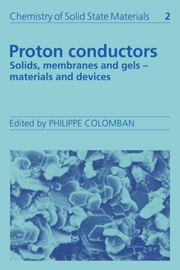Book contents
- Frontmatter
- Contents
- List of contributors
- Preface
- Symbols
- I HYDROGEN BOND AND PROTONIC SPECIES
- II MATERIALS: PREPARATION, STRUCTURES AND PROPERTIES
- 7 Structure and characterization of hydrogen insertion compounds of metal oxides
- 8 High temperature proton conductors based on perovskite-type oxides
- 9 Highly ionic hydroxides: unexpected proton conductivity in Mg(OH)2 and homologues
- 10 Ice
- 11 Anhydrous materials: oxonium perchlorate, acid phosphates, arsenates, sulphates and selenates
- 12 Hydrogen behaviour in graphite–nitric acid intercalation compounds
- 13 Proton-containing β- and β″-alumina structure type compounds
- 14 Proton conduction in zeolites
- 15 Proton containing NASICON phases
- 16 Phosphates and phosphonates of tetravalent metals as protonic conductors
- 17 Hydrogen uranyl phosphate, H3OUO4PO4. 3H2O (HUP), and related materials
- 18 From crystalline to amorphous (particle) hydrates: inorganic polymers, glasses, clays, gels and porous media
- 19 Perfluorinated membranes
- 20 Mixed inorganic-organic systems: the acid/polymer blends
- III PROTON DYNAMICS AND CHARGE TRANSPORT
- IV PROTON DIFFUSION MECHANISMS
- V DEVICES
- Index
9 - Highly ionic hydroxides: unexpected proton conductivity in Mg(OH)2 and homologues
Published online by Cambridge University Press: 04 May 2010
- Frontmatter
- Contents
- List of contributors
- Preface
- Symbols
- I HYDROGEN BOND AND PROTONIC SPECIES
- II MATERIALS: PREPARATION, STRUCTURES AND PROPERTIES
- 7 Structure and characterization of hydrogen insertion compounds of metal oxides
- 8 High temperature proton conductors based on perovskite-type oxides
- 9 Highly ionic hydroxides: unexpected proton conductivity in Mg(OH)2 and homologues
- 10 Ice
- 11 Anhydrous materials: oxonium perchlorate, acid phosphates, arsenates, sulphates and selenates
- 12 Hydrogen behaviour in graphite–nitric acid intercalation compounds
- 13 Proton-containing β- and β″-alumina structure type compounds
- 14 Proton conduction in zeolites
- 15 Proton containing NASICON phases
- 16 Phosphates and phosphonates of tetravalent metals as protonic conductors
- 17 Hydrogen uranyl phosphate, H3OUO4PO4. 3H2O (HUP), and related materials
- 18 From crystalline to amorphous (particle) hydrates: inorganic polymers, glasses, clays, gels and porous media
- 19 Perfluorinated membranes
- 20 Mixed inorganic-organic systems: the acid/polymer blends
- III PROTON DYNAMICS AND CHARGE TRANSPORT
- IV PROTON DIFFUSION MECHANISMS
- V DEVICES
- Index
Summary
Introduction
Hydrogen bonding is considered a prerequisite for proton conduction. The underlying rationale is that protons can jump with relative ease only when the energy barriers between donor and acceptor sites are low. The corollary is that, when energy barriers are high, proton conductivity is not expected to occur.
Since the idea of low energy barriers is intuitively appealing, the search for proton conductors has concentrated worldwide on systems with recognizable H-bonding, both in inorganic systems and biological membranes. This has created a bias which may have prevented the recognition of some important proton transport mechanisms that appear to be present in non H-bonded system.
In this chapter, I shall discuss highly ionic hydroxides that are probably the least likely candidates for proton conduction. However, on closer inspection, they reveal an interesting fundamental behaviour that may be important for understanding proton transport in other systems, for instance across bilayer membranes containing inner sections that are considered to be proton impermeable.
Non-hydrogen bonded systems
Inorganic hydroxides with the highest degree of ionicity are the binary hydroxides of the alkali and alkaline earth metals, MeIOH and MeII(OH)2 with MeI = Na+, K+ …, and MeII = Mg2+, Ca2+ …, respectively. They all contain well-defined, essentially non H-bonded OH– anions.
Most alkali hydroxides undergo a rotational transition prior to melting.
- Type
- Chapter
- Information
- Proton ConductorsSolids, Membranes and Gels - Materials and Devices, pp. 138 - 157Publisher: Cambridge University PressPrint publication year: 1992
- 6
- Cited by



